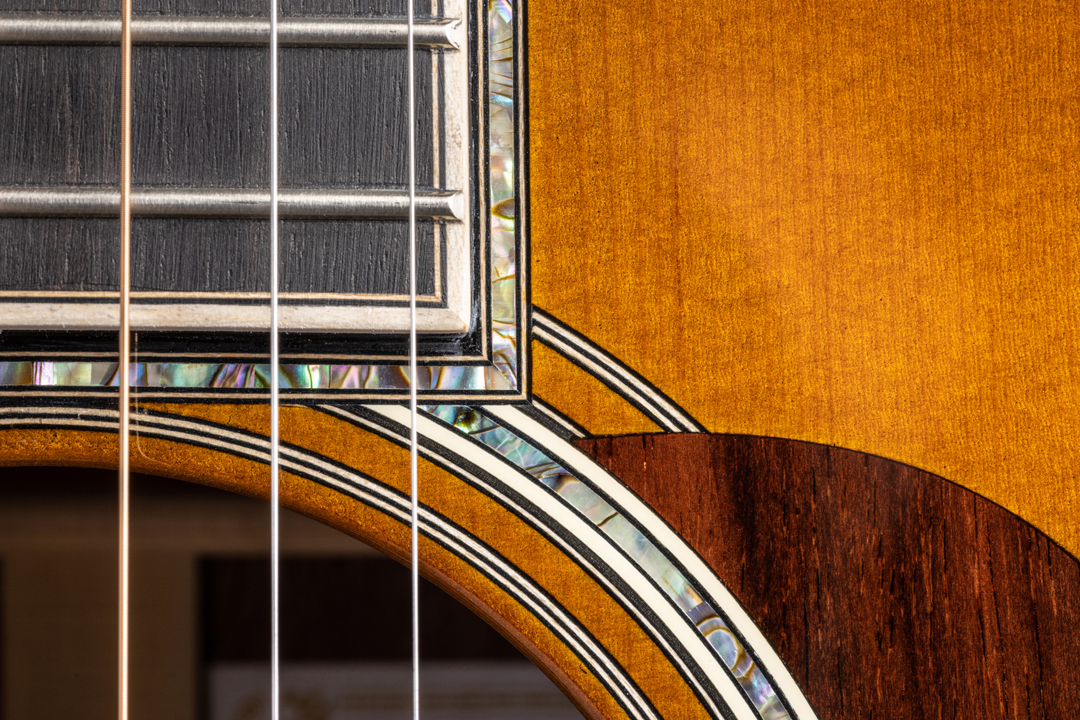Martin Guitar’s CEO Thomas Ripsam presents his CEO-10 model
NAMM 2023 has a Best in Show candidate in this short-scale 000 guitar
Specs include: Solid tonewoods throughout, 14-fret 000 body size; figured Guatemalan rosewood back and sides, FSC certified European spruce top with 1933 Ambertone shading and Style 42 abalone purling and rosette; 1/4″ scalloped FSC certified European spruce bracing with Golden Era scalloping, composite carbon fiber/torrefied Adirondack spruce bridge plate; solid South American mahogany short-scale neck with Vintage Deluxe profile and two-way adjustable titanium alloy support rod; ebony fingerboard with Higher Performance taper, 1-3/4″ width at the bone nut, 2-/8″ width at the 12th fret, abalone fret position markers in circa 1917 William Foden pattern; ebony belly bridge with bone drop-in saddle and 2-5/32″ string spacing, and Style 42 snowflake inlays; wood fiber accents and back strip; flamed European maple binding on the body, neck, and headstock; Guatemalan rosewood headstock face plate with abalone 1932 C. F. Martin & Co. script logo over 1930 Style 45 Deluxe abalone torch inlay; Waverly open-back butter bean tuning machines; Guatemalan rosewood pickguard with abalone Style 45 Deluxe floral inlay. Limited to 100 instruments.
| “The Martin CEO-10 has a full-bodied voice with impressive bass response and an expansive, ethereal projection that sounds much more like a long-scale OM to my ear, than the typical gathered and punchy sound of a short-scale 000. Yet it offers the playability of the shorter string scale, made all the more comfortable thanks to the asymmetrical Vintage Deluxe neck profile.” |
Sonic and Visual Radiance
The Martin CEO-10 is a limited edition designed by the company’s Chief Executive Officer and is the 10th installment of the CEO Series, which began in 1997 and all came from the mind of C. F. Martin IV, until now. The CEO-10 is the first model designed by current Martin CEO Thomas Ripsam, Chris Martin having retired in 2021.

By far the most expensive model in the series, the CEO-10 strives to deserve its lofty price tag and succeeds marvelously. It is the first traditional short-scale auditorium-size 000 made in the CEO Series and it is lavishly embellished with ornate abalone inlays similar to Martin’s Style 42, greatly enhanced with historical tokens of long-ago vintage Martins, all gracing exquisite tonewoods of species relatively new to Martin guitars, Guatemalan rosewood for the back and sides fronted by FSC certified European spruce under a 1933 Ambertone top shading. Every aspect is of uncompromising quality and exhibits recent trends in luxury model design at Martin that are reincarnated from the company’s cherished past with a modern sensibility and some ultra-modern engineering under the hood.
Guatemalan rosewood varies greatly in the look of its grain and in terms of its color, which can range from Brazil nut brown to cocobolo purplish black, to light beige or rosy hues. Mr. Ripsam selected nicely figured sets that have a pale peachy tint when unfinished and can give off wood tones from cherry to olive to walnut once they are under the high gloss nitrocellulose lacquer finish.
The headstock face plate is also made of Guatemalan rosewood, as is the pickguard, each showing contrasting color palettes from that used for the back and sides. The prototype I played did not have grain as amazing as #1 of edition shown in these photos. But in any case, the lighter coloring of the body shows off the complex grain patterns wonderfully while also performing a bit of a parlor trick on the mind of the beholder – or the behearer, as it were.
The color of guitar I played gave it the appearance of something from the myrtle or acacia families, which produce guitars that can sound pretty but lack the tonal gravitas heard from rosewood. However, the CEO-10 has a classic rosewood voice, rich and complex, with a warm bottom end and lustrous harmonic overtones that radiate with the defuse and blended glow that is the hallmark of a European spruce soundboard.
(click to enlarge)
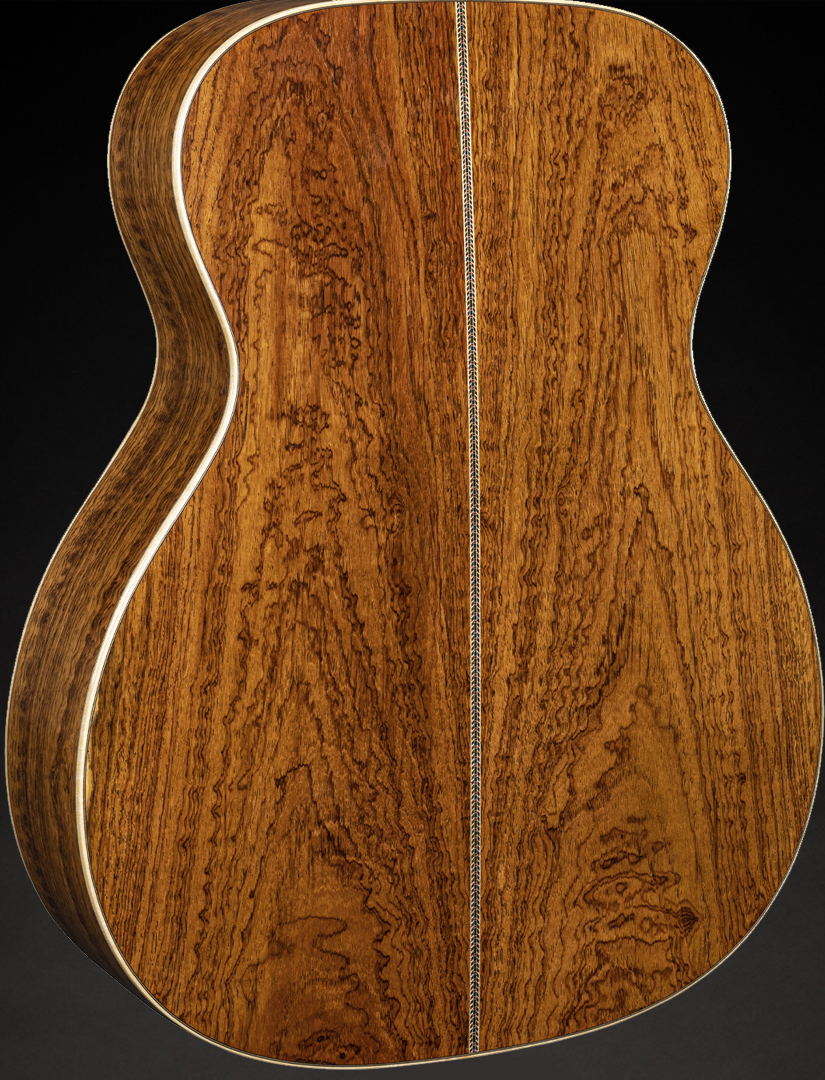 |
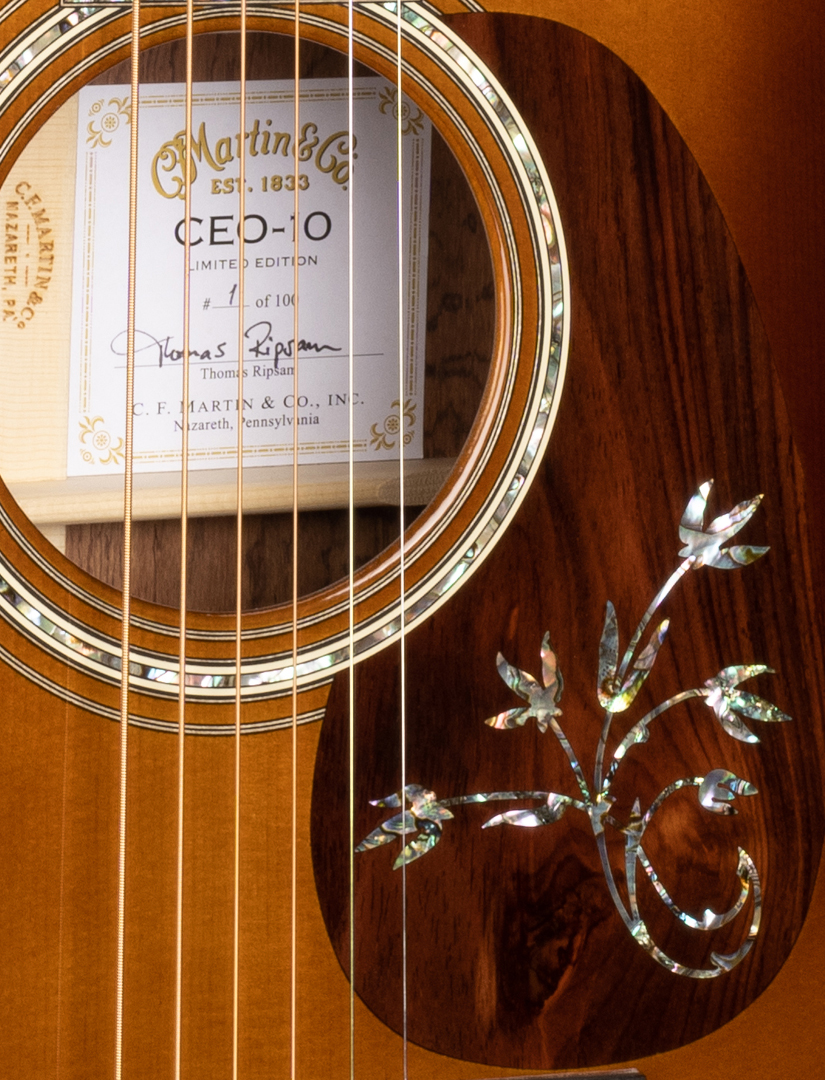 |
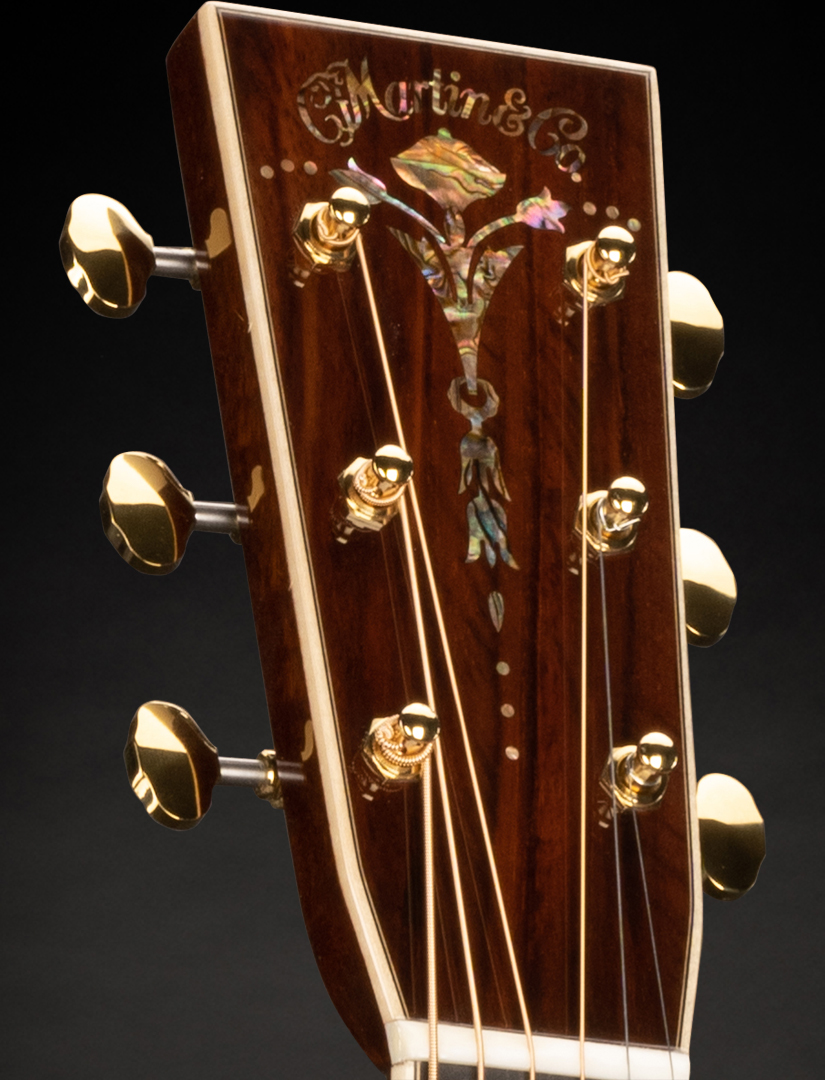 |
The spruce comes from a woodland certified by the Forest Stewardship Council as being managed in a responsible and sustainable manner. The world-wide efforts of the FSC have been supported by C. F. Martin IV for decades and the company will continue to source and feature FSC certified wood and other environmentally-friendly materials hereafter.
According to Martin sources, European spruce was chosen because the new CEO was born in Germany, just like C. F. Martin Sr. The bracing under the soundboard is also European spruce, which is somewhat unusual. European spruce is softer and less stiff than the Sitka or Adirondack varieties of spruce typically used for bracing.
These braces are not just scalloped to further increase flexibility, they have the 1/4″ width used on Orchestra Models, rather than the 5/6” width used on most 000s. OMs have the same body size as a 000 but are made with a long-scale neck. The 1/4″ bracing typically increases body resonance. But depending upon the type of bracing, they can also result in a guitar having a lower attack ceiling, so that the top goes into overdrive with fundamental note distortion when strummed vigorously with a pick.
That seems to hold true with this model, when it comes to attacking the strings, as one might when playing a dreadnought. But it is totally worth it because of its excellent responsiveness to gentler, nuanced playing. For the record, the CEO-10 has much wider dynamics and a higher attack ceiling than ultra-light Martins like the CS-OM-13.
Special Features, Special Tone
The Martin CEO-10 has a full-bodied voice with impressive bass response and an expansive, ethereal projection that sounds much more like a long-scale OM to my ear, than the typical gathered and punchy sound of a short-scale 000. Yet it offers the playability of the shorter string scale, made all the more comfortable thanks to the asymmetrical Vintage Deluxe neck profile.
Other features borrowed from the Modern Deluxe Series, but not visible outside the guitar, include the composite bridge plate made from a thin piece of Vintage Tone System torrefied Adirondack spruce protected between two very thin plates of carbon fiber. This exclusive bridge plate design promotes volume and sustain while preventing the ball end of the strings from chewing up the wooden plate. The model also has the smaller than normal neck rod but it is made from an alloy enhanced with titanium for greater support without displacing as much wood from the interior of the solid Big Leaf mahogany neck.
It also has the Golden Era style brace scalloping, removing more wood from the braces compared to the Standard Series Martins, but less wood than is removed on Martin’s Authentic Series instruments. This bracing contributes to how well the CEO-10 responds with so much tone from so little effort.
The guitar invites the guitarist to relax when strumming or fingerpicking, allowing the instrument to attain and then maintain optimum resonance, in what I call “the tone zone,” where the voice ignites into a warm and sparkling conflagration of colorful, beautiful sound. That conservative attack ceiling but astonishing sweet spot of magnificent resonance is something it shares with the finest vintage Martins.
Vintage Deluxe and Then Some
The Vintage Deluxe neck shape was introduced in the Modern Deluxe Series with its futuristic engineering. But the neck is the most traditional feature. Not only does it have a traditional, full-size dovetail neck joint and solid mahogany neck block, the shape of the neck’s profile is copied from the 1930 OM-45 Deluxe owned by the Martin Museum. It is my all-time favorite neck.
That original OM neck is much lower in profile than most vintage guitar necks and is ingeniously carved. There is subtly more mass on the bass side for the thumb to hold onto and a faster slope to the treble side where the fingers wrap around to the strings.
The apex of the mild V at the back of the neck drifts in an asymmetrical manner. When the hand moves up the fingerboard, turning parallel to the floor as the elbow draws near the player’s body, the apex of the neck stays comfortably nestled in the crease of the player’s palm at every position. It is hardly noticeable, but not noticing the neck profile is the sign of a great neck shape.
Having recently played the 1930 OM in comparison with the Vintage Deluxe neck, I was reminded of just how similar they really are. The major difference in the Vintage Deluxe version is that it has a modern heel where the neck attaches to the body, so the profile remains very low and super-comfy all the way to the 14th fret. The CEO-10 also has the High Performance taper to the ebony fingerboard, making it even faster and sleeker than the Standard Taper found on the OM-28 Modern Deluxe and the old OM in the museum.
As far as I remember, this the first official Martin model to have this neck shape outside of the Modern Deluxe Series. It also has several cosmetic specs borrowed from the MD models as well. The high-color abalone inlay on the top and bridge is identical to Style 42 instruments in the Standard and Modern Deluxe Series, except for the snowflake on each side of the ebony bridge. Instead of a circular snowflake there is an elegant inlay that looks like four crowns pointing in opposing directions, similar to a snowflake seen on the fingerboards of various pre-war 000-42s.
The fingerboard on the CEO-10 stands apart from other modern Martins because it has the fret position markers that were invented for the guitars ordered by William Foden between 1911 and 1917. Foden was among the premiere concert soloists in America around the turn of the previous century and a notable composer and teacher who sold Martin guitars to his students. These markers have appeared rarely on other modern Martin, like the MC District Sales Manager and the 00-DB Jeff Tweedy signature model. I have always admired them and thought it was an inspired choice to have such a simple yet elegant fingerboard pattern in juxtaposition with the other elaborate pearl inlay on the CEO-10.
(click to enlarge)
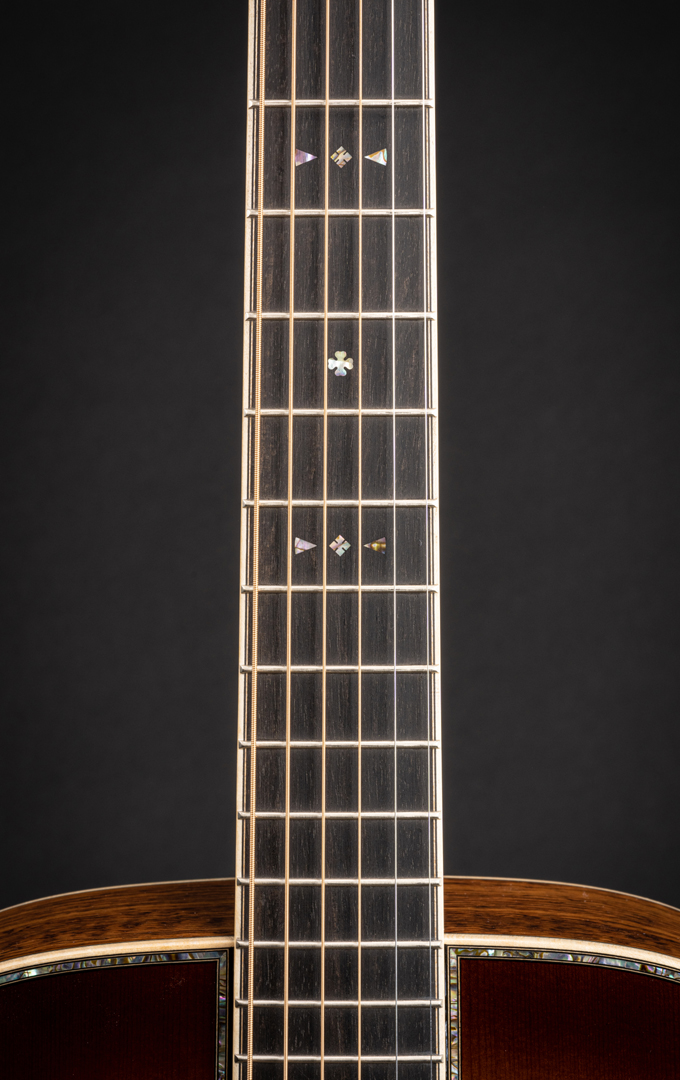 |
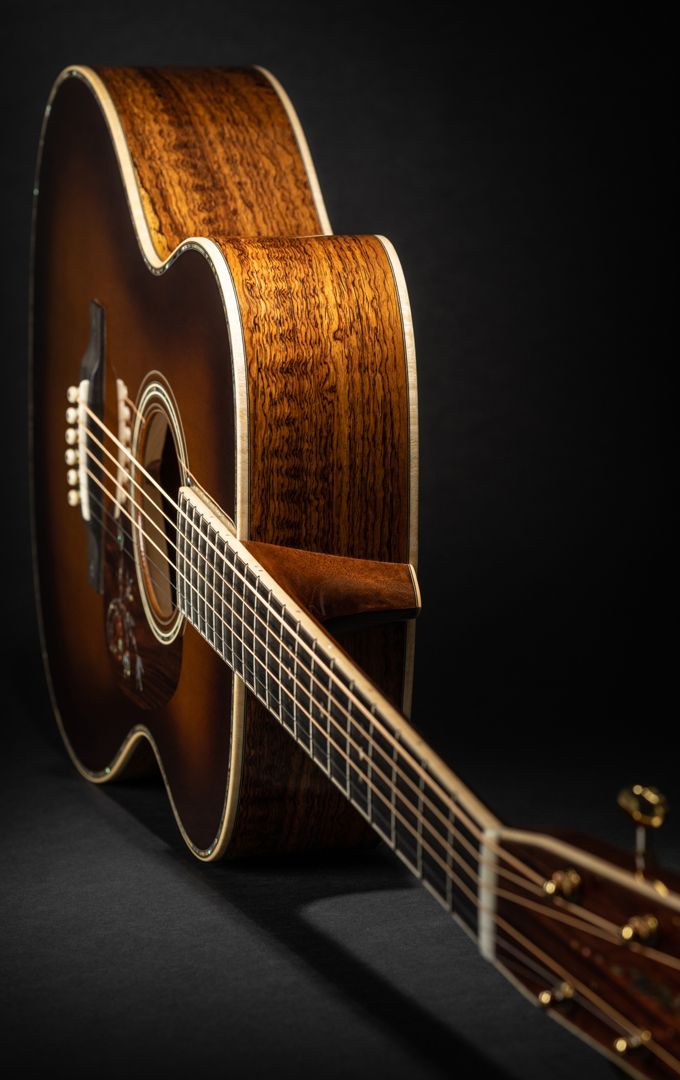 |
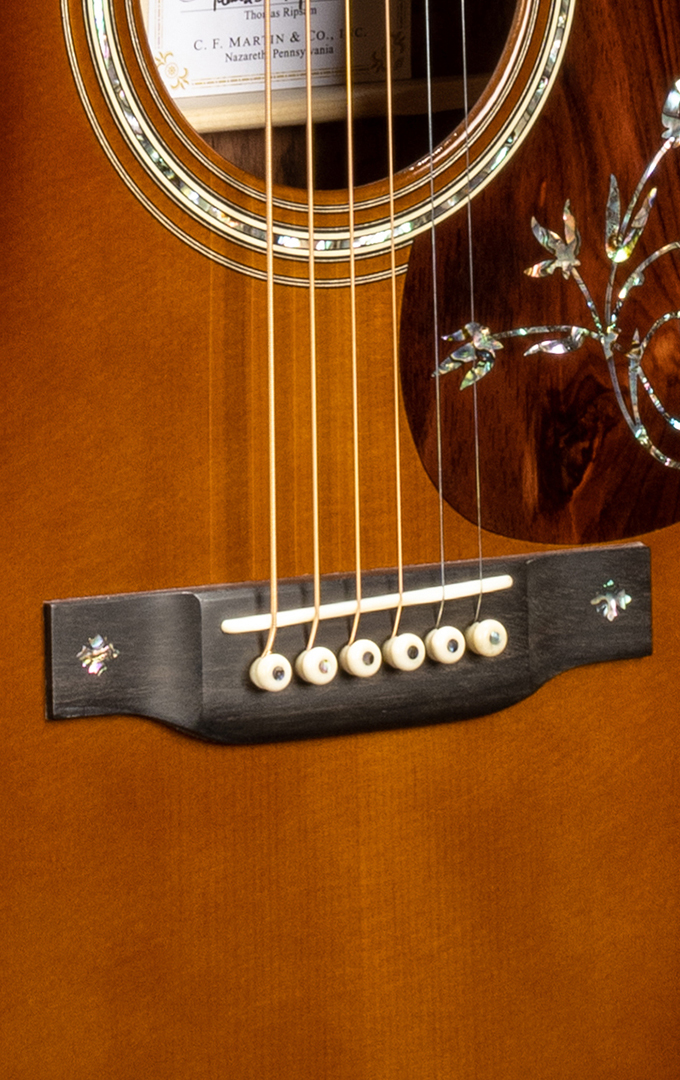 |
All the non-pearl inlay surrounding the abalone on the body is made from wood fiber as on Modern Deluxe instruments. It appears to be maple, either died black or left to its natural color. The bindings are made of a highly flamed European maple and are also used to bind the fingerboard and the headstock. The back strip is likewise made entirely of colorful wood fiber in the pattern used on Style 45 and Style 42 Martins in the Authentic Series.
Another feature from the Modern Deluxe Series is seen on the headstock’s Guatemalan rosewood face plate. There is the colorful abalone C. F. Martin & Co. script logo, in a particularly ornate design that appeared only in 1932. But under it is a gorgeous torch inlay that was used on Style 45 Martins in the 1920s, but is now associated with the last vintage model to use it, the 1930 OM-45 Deluxe, of which only 11 were made. The new pearly Modern Deluxe models have the torch, while those made in Styles 18 and 28 have the 1932 abalone script. The CEO-10 has both and can therefore be seen as even Deluxer than a Modern Deluxe Martin.
Each CEO-10 is unique when it comes to the torch, as they are inlaid by hand by a craftsperson using very small pieces of abalone chosen to work together when creating the iconic torch. Each torch is unlike any other. So too are the special pickguard inlays truly unique.
The Guatemalan rosewood pickguard is adorned with the abalone floral design that appeared on 10 of the 11 1930 OM-45 Deluxe guitars. In some interviews and videos I claimed the CEO-10 pickguard design was taken from Roy Rogers’ guitar. I had gotten my 45 Deluxes mixed up. Rogers ended up with the very first one built, which has a different floral pattern. In any case, the CEO10’s pickguard looks beautiful and ties in well with the abalone accents inlaid in the ebony bridge.
With all due respect to Chris Martin, the CEO-10 takes the whole concept to a loftier level. While the double headstock inlays might press the envelope of what Mr. Martin’s great-grandfather used to call “ornate but not ostentatious,” the CEO-10 is an exquisite museum-worthy instrument of sonic and visual radiance and a very impressive first public milestone in the tenure of Thomas Ripsam. May it prove a signpost to what lay ahead for the company moving forward, led by its current CEO.
And that’s one man’s word on…
The Martin CEO-10
$8,999.00
More Photos Here
Additional Reading
Satin Finish Martins Arrive in the Standard Series
Official Spec Sheet Here
~
